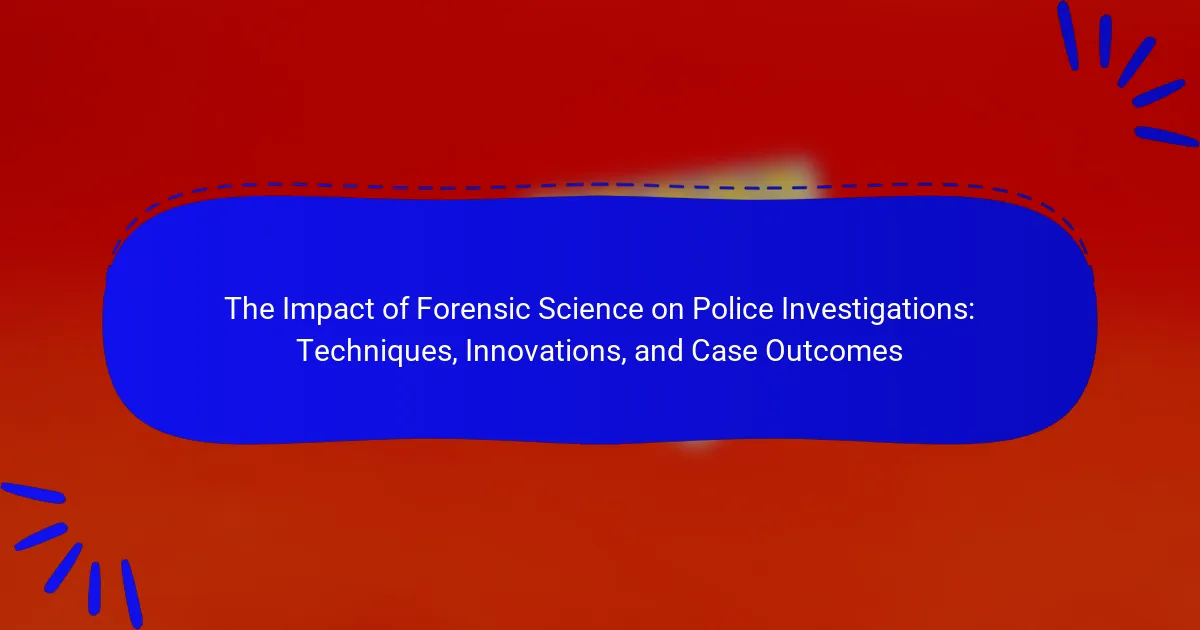
What is the impact of forensic science on police investigations?
Forensic science significantly enhances police investigations. It provides objective evidence that can link suspects to crime scenes. Techniques include DNA analysis, fingerprinting, and ballistics. These methods increase the accuracy of investigations. For instance, DNA evidence has exonerated wrongfully convicted individuals. According to a study by the National Institute of Justice, DNA testing has solved thousands of cold cases. Forensic science also aids in crime scene reconstruction. This helps law enforcement understand the sequence of events. Overall, forensic science improves the reliability of evidence in legal proceedings.
How does forensic science enhance investigative processes?
Forensic science enhances investigative processes by providing scientific analysis of evidence. This analysis helps in identifying suspects, reconstructing crime scenes, and establishing timelines. Techniques such as DNA profiling can link individuals to specific crimes with high accuracy. Additionally, fingerprint analysis can uniquely identify a person at a crime scene. Forensic evidence often serves as crucial support in court, increasing the likelihood of convictions. Studies show that cases with forensic evidence have higher clearance rates. For example, the use of forensic DNA has led to the exoneration of wrongfully convicted individuals. Overall, forensic science significantly improves the reliability and effectiveness of criminal investigations.
What are the key techniques used in forensic science?
Key techniques used in forensic science include DNA analysis, fingerprinting, and ballistics. DNA analysis identifies individuals based on their unique genetic makeup. This technique can match biological samples to suspects with high accuracy. Fingerprinting examines the unique patterns of ridges and valleys on fingers. It is a reliable method for identifying individuals at crime scenes. Ballistics studies the behavior of firearms and ammunition. This technique helps link weapons to specific crimes. Other techniques include toxicology, which analyzes bodily fluids for substances, and digital forensics, which recovers data from electronic devices. Each of these methods contributes significantly to solving crimes and supporting investigations.
How do these techniques improve evidence collection?
Forensic techniques improve evidence collection by enhancing accuracy and reliability. These techniques include DNA analysis, fingerprinting, and digital forensics. DNA analysis can identify individuals with a high degree of certainty, often with probabilities exceeding 99.9%. Fingerprinting provides unique identifiers that link suspects to crime scenes. Digital forensics retrieves data from electronic devices, uncovering crucial evidence. The use of these methods reduces human error and biases in evidence collection. Forensic science also facilitates the preservation of evidence, ensuring it remains uncontaminated. Overall, these advancements lead to more effective investigations and higher conviction rates.
Why is forensic science crucial in modern law enforcement?
Forensic science is crucial in modern law enforcement because it provides objective evidence that can link suspects to crimes. This scientific approach enhances the accuracy of investigations. Forensic techniques include DNA analysis, fingerprinting, and ballistics. These methods have been pivotal in solving cases that would otherwise remain unsolved. For instance, DNA evidence has exonerated wrongfully convicted individuals. According to the Innocence Project, over 375 people have been exonerated in the U.S. through DNA testing. Additionally, forensic science aids in crime scene reconstruction, helping investigators understand the sequence of events. The integration of technology in forensic science continues to evolve, improving investigative outcomes. Overall, forensic science strengthens the integrity of the criminal justice system.
What role does forensic science play in solving crimes?
Forensic science plays a crucial role in solving crimes by providing scientific analysis of evidence. It helps law enforcement identify suspects through DNA profiling, fingerprint analysis, and ballistics. Forensic techniques can link a suspect to a crime scene or victim. The use of forensic evidence often strengthens cases in court. For example, DNA evidence has been pivotal in securing convictions. According to the Innocence Project, DNA testing has exonerated over 375 wrongfully convicted individuals in the U.S. This highlights the reliability of forensic science in the criminal justice system.
How does forensic science contribute to justice and public safety?
Forensic science contributes to justice and public safety by providing objective evidence in criminal investigations. It utilizes scientific methods to analyze physical evidence, such as DNA, fingerprints, and ballistics. This analysis helps law enforcement identify suspects and link them to crimes. Forensic evidence can also exonerate innocent individuals, preventing wrongful convictions. According to the Innocence Project, DNA evidence has exonerated over 375 wrongfully convicted people in the United States. Additionally, forensic science enhances crime scene investigations, ensuring that evidence is collected and preserved properly. This systematic approach aids in building strong cases for prosecution and supports public trust in the justice system.

What innovations in forensic science are shaping police investigations?
Innovations in forensic science that are shaping police investigations include advancements in DNA analysis, digital forensics, and forensic anthropology. DNA analysis has become faster and more accurate, allowing for quicker identification of suspects. Techniques such as next-generation sequencing enable the analysis of degraded samples. Digital forensics has evolved with tools that can extract data from smartphones and computers, aiding in cybercrime investigations. Forensic anthropology provides insights into human remains, helping to establish identities and cause of death. Additionally, the use of artificial intelligence in analyzing evidence streamlines the investigative process. These innovations enhance the accuracy and efficiency of police work, leading to higher conviction rates.
How have technological advancements influenced forensic techniques?
Technological advancements have significantly influenced forensic techniques by enhancing accuracy and efficiency. DNA analysis has evolved with techniques like PCR, allowing for the amplification of small DNA samples. This advancement has enabled the identification of suspects with greater precision. Digital forensics has also improved, utilizing advanced software to recover deleted data from electronic devices. This has become crucial in cybercrime investigations. Additionally, 3D scanning technology provides accurate crime scene reconstructions, aiding in visualizing evidence. These innovations have led to higher conviction rates and more exonerations of the wrongly accused. Overall, technology has transformed forensic science into a more reliable and effective tool for law enforcement.
What are some examples of new forensic technologies?
Examples of new forensic technologies include DNA phenotyping, advanced fingerprint analysis, and digital forensics. DNA phenotyping predicts physical appearance from genetic material. This technology can assist in identifying suspects when traditional DNA matching is not possible. Advanced fingerprint analysis uses machine learning algorithms to enhance the accuracy of fingerprint identification. Digital forensics involves recovering and analyzing data from electronic devices. These technologies have significantly improved the efficiency and effectiveness of police investigations. They provide new avenues for evidence collection and suspect identification.
How do these innovations streamline investigative workflows?
Innovations in forensic science streamline investigative workflows by enhancing efficiency and accuracy. These advancements include automated analysis tools and data integration systems. Automated tools reduce manual labor and speed up evidence processing. Data integration allows for seamless sharing of information across departments. This leads to quicker decision-making and improved collaboration among investigators. For example, DNA analysis technology can now produce results in hours instead of weeks. Furthermore, predictive analytics can identify potential suspects based on historical data. Overall, these innovations significantly shorten the time from evidence collection to case resolution.
What are the emerging trends in forensic science?
Emerging trends in forensic science include advancements in DNA analysis, digital forensics, and the use of artificial intelligence. DNA analysis is becoming faster and more accurate, enabling quicker identification of suspects. Digital forensics focuses on recovering data from electronic devices, as cybercrime increases. Artificial intelligence is being used to analyze large data sets, improving evidence processing. Additionally, forensic science is incorporating 3D imaging for crime scene reconstruction. These trends enhance the accuracy and efficiency of investigations, leading to better case outcomes.
How is artificial intelligence being integrated into forensic analysis?
Artificial intelligence is being integrated into forensic analysis through advanced data processing and pattern recognition. AI algorithms analyze large volumes of data quickly. They assist in identifying patterns that human analysts might miss. For example, AI can enhance [censured] recognition technology in identifying suspects. Machine learning models can also predict criminal behavior based on historical data. Additionally, AI tools help in analyzing digital evidence from devices. These integrations improve the accuracy and efficiency of forensic investigations. Studies show that AI can reduce analysis time by up to 75%.
What impact do these trends have on case outcomes?
Trends in forensic science significantly impact case outcomes. Enhanced techniques improve the accuracy of evidence analysis. For example, DNA profiling has increased conviction rates by providing definitive links to suspects. Innovations like digital forensics aid in uncovering crucial data from electronic devices. These advancements reduce wrongful convictions and increase the likelihood of solving cold cases. Studies show that jurisdictions employing advanced forensic methods see higher case closure rates. Furthermore, the integration of new technologies fosters collaboration among law enforcement agencies. Overall, these trends lead to more reliable investigations and just outcomes in the judicial system.

What are the outcomes of using forensic science in police investigations?
The outcomes of using forensic science in police investigations include increased accuracy in solving crimes. Forensic science provides objective evidence that can link suspects to crime scenes. Techniques such as DNA analysis have revolutionized the identification of individuals. In many cases, forensic evidence has led to the exoneration of wrongfully convicted individuals. The use of forensic science can also enhance the credibility of investigations in court. Studies show that cases with forensic evidence have higher conviction rates. Furthermore, advancements in technology continue to improve the effectiveness of forensic methods. Overall, forensic science significantly contributes to the efficiency and reliability of police investigations.
How does forensic evidence affect case resolution?
Forensic evidence significantly impacts case resolution by providing objective data that can confirm or refute claims. This evidence can include DNA, fingerprints, and ballistics, which help establish connections between suspects and crime scenes. Forensic analysis increases the likelihood of solving cases by offering scientifically validated information. Studies show that cases with forensic evidence have higher conviction rates. For example, the Innocence Project reports that DNA evidence has exonerated over 375 individuals wrongfully convicted. Such evidence can also lead to the identification of unknown suspects, enhancing investigative leads. Overall, forensic evidence is crucial in ensuring justice and promoting accurate legal outcomes.
What percentage of cases are solved with forensic evidence?
Approximately 90% of cases are solved with forensic evidence. Forensic evidence plays a crucial role in criminal investigations. It includes DNA, fingerprints, and ballistic analysis. Studies show that cases with forensic evidence are more likely to lead to convictions. For example, a report by the National Institute of Justice indicates that forensic evidence significantly enhances case resolution rates.
How does forensic science impact the reliability of witness testimonies?
Forensic science enhances the reliability of witness testimonies by providing objective evidence. This evidence can corroborate or contradict what witnesses claim to have seen or heard. Techniques such as DNA analysis and fingerprinting offer definitive proof that can confirm a suspect’s presence at a crime scene. Studies show that eyewitness accounts can be inaccurate due to factors like stress or poor lighting. Forensic evidence serves as a check against these errors. A report from the National Academy of Sciences emphasizes the importance of forensic science in validating or challenging witness statements. This combination of objective data and subjective accounts leads to more accurate case outcomes.
What challenges do police face when utilizing forensic science?
Police face several challenges when utilizing forensic science. One major challenge is the complexity of forensic techniques. Many methods require specialized knowledge and training. This can lead to misinterpretation of evidence if not handled correctly. Another challenge is the cost associated with forensic testing. High-quality forensic analysis can be expensive and may strain police budgets. Additionally, there can be delays in processing forensic evidence. Backlogs in crime labs can extend the time it takes to receive results. Furthermore, the evolving nature of forensic technology poses challenges. Police must stay updated on new techniques and methodologies. There is also the issue of admissibility in court. Forensic evidence must meet strict legal standards to be considered valid. Lastly, public perception and media influence can complicate forensic investigations. Misunderstandings about forensic science can lead to unrealistic expectations in criminal cases.
How do resource limitations affect forensic investigations?
Resource limitations significantly hinder forensic investigations. Limited funding restricts the availability of advanced technology and equipment. Insufficient staffing leads to delays in processing evidence. Reduced resources can result in fewer forensic tests conducted. This may compromise the quality of investigations. Forensic labs often face backlogs due to high case volumes and low resources. A study by the National Institute of Justice highlights that resource constraints directly impact case outcomes. These limitations can lead to wrongful convictions or unaddressed crimes. Overall, resource limitations diminish the effectiveness of forensic science in law enforcement.
What are the common pitfalls in forensic analysis?
Common pitfalls in forensic analysis include contamination of evidence, misinterpretation of data, and inadequate documentation. Contamination can occur when evidence is not properly collected or stored. This can lead to compromised results and unreliable conclusions. Misinterpretation of data often arises from a lack of understanding of statistical significance or methodological flaws. Inadequate documentation can result in loss of critical information, making it difficult to replicate findings. Each of these pitfalls can severely impact the integrity of forensic investigations and the outcomes of police cases.
What best practices should be followed in forensic investigations?
Best practices in forensic investigations include maintaining a secure crime scene, collecting evidence meticulously, and documenting each step of the process. Secure crime scenes prevent contamination and preserve evidence integrity. Collecting evidence must follow established protocols to ensure reliability. Proper documentation includes photographs, sketches, and detailed notes, which support the investigation’s findings. Chain of custody must be maintained to track evidence handling. Additionally, forensic experts should be utilized for specialized analyses. Regular training for investigators is essential to keep up with advancements in forensic science. Adhering to these practices increases the accuracy and credibility of forensic evidence in legal proceedings.
How can law enforcement agencies improve their forensic capabilities?
Law enforcement agencies can improve their forensic capabilities by investing in advanced training and technology. Enhanced training ensures that personnel are up-to-date with the latest forensic techniques. Implementing state-of-the-art technology, such as DNA analysis tools and digital forensics software, increases accuracy. Collaboration with academic institutions can provide access to research and innovative methods. Establishing standardized protocols improves consistency in forensic evidence handling. Regular audits and assessments of forensic practices help identify areas for improvement. Funding for forensic laboratories can expand their capacity and capabilities. These steps lead to more reliable and efficient investigations.
What training is essential for personnel involved in forensic science?
Essential training for personnel involved in forensic science includes formal education in forensic science or a related field. This typically requires a bachelor’s degree in forensic science, biology, chemistry, or criminal justice. Training must also cover specialized techniques in evidence collection and preservation. Personnel should be proficient in laboratory analysis methods, including DNA analysis and toxicology. Additionally, understanding legal standards and ethical considerations in forensic work is crucial. Field training and internships provide practical experience, enhancing skills in real-world scenarios. Continuous education is necessary to stay updated on technological advancements and new methodologies in forensic science.
The main entity of this article is forensic science and its impact on police investigations. The article explores how forensic science enhances investigative processes through techniques such as DNA analysis, fingerprinting, and ballistics, which improve evidence collection and case resolution. It highlights innovations in forensic science, including advancements in digital forensics and the integration of artificial intelligence, that streamline workflows and increase accuracy. Additionally, the article discusses the challenges faced by law enforcement in utilizing forensic science, such as resource limitations and common pitfalls in analysis, while emphasizing best practices for improving forensic capabilities and training for personnel involved in these investigations.
